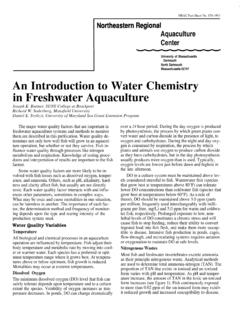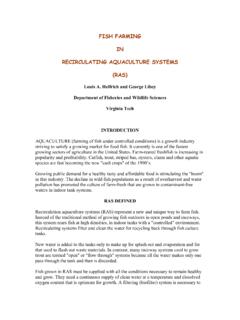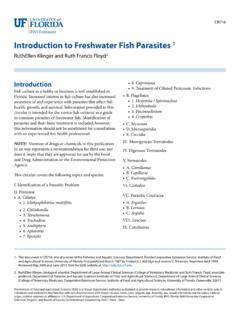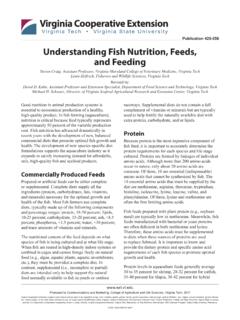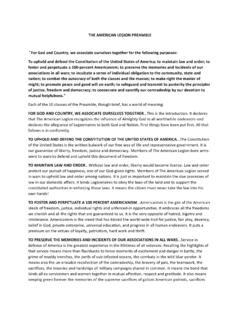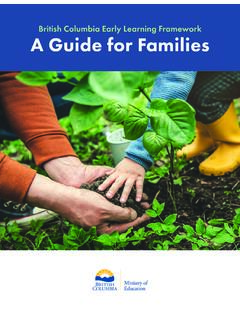Transcription of Aquaponics Growing Fish and Plants Together
1 AquaponicsGrowing Fish and Plants TogetherPresented by: JD SawyerAquaponics DefinedThe integration of: Aquaculture Growing fish in a re-circulating system Ponos The Greek word for Growing Plants with or without media Most people relate Growing Plants to hydroponics since both use nutrient rich water and both use soil-less media. How Aquaponics are raised in a from the fish tank is pumped to the convert ammonia and nitrite to absorb the nutrient rich water is returned to the fish tank, cleanFish are Happy! Plants are Happy!We get more to eat!Why is it Considered Sustainable? Waste from fish is used to feed the Plants Fish and Plants create a polyculture producing two products Water is re-used in the re-circulating system Local food production, enhances the local economy and reduces food transportation Continuous organic fertilizerATTRA National Sustainable Agriculture Information ServiceWhy Aquaponics ?
2 Uses a fraction of the water, about 10% of soil Growing No need to purchase, store and apply fertilizer No soil-borne diseases, no tilling, no weeds Grow two food products Together , protein and produce High fish stocking density, high crop yield No waste hydroponics waste solution, aquaculture waste fish solids Aquaponics all waste is used No pesticides or herbicides, only fish fertilizer Food security, grow your own food, indoors, year-round Works in draught or places with poor soil qualityWater use comparison Open-water net pens Infinite number of gallons per pound of production Non-recirculating raceways and tanks 5,000 to 10,000 gallons per pound of production Non-recirculating ponds 500 to 1,000 gallons per pound of production Recirculating systems 5 to 10 gallons per pound of production Integrated Aquaponics Wastewater directed to greenhouses.
3 No dischargeAquaponics Components Fish Tank Place to Grow Plants Water Pump(s) Air Pump Irrigation Tubing Water Heater (Optional) Filtration (Optional) Grow light (Optional) Fish and Plants Aquarium Stock Tank Half Barrel Rubber-made TubSmall Fish TankMedium Sized Fish Tanks IBC totes(make sure you know what wasin them before) Bath tubs Plastic, Steelor FiberglassStock Tanks Build your ownBig Fish Tanks Open Ponds Large Stock Tanks Swimming Pools Fiberglass TanksSafe MaterialsMake sure all your system components are fish and human safe Polypropylene - labeled PP High Density Polyethylene - labeled HDPE High Impact ABS (Hydroponic Grow Trays) Stainless Steel barrels EPDM or PVC (poly vinyl chloride) pond liner (make sure its UV resistant and avoid fire retardant material) Fiberglass tanks and grow beds Rigid white PVC pipe and fittings, black f lexible PVC tubing, some ABS DO NOT use Copper Its toxic to the fishAquaponic System Designs Media-Based Growbed Growing Power System Raft System NFT (Nutrient Film Technique) Towers VertiGroMedia-Based Growbed Gravel Hydroton Lava Rock Packing Foam Sponges Perilite VermiculiteMedia GrowbedsPros Work great for most hobby Aquaponics Easy to find components, easy to build You can grow lots of different Plants in one system Make as big or small as you wantCons Can build-up anaerobic zones May need to be cleaned out occasionally (or use worms)Aquarium SystemsBarrel-Ponics ExamplesInvented by Travis Hughey of Faith and Sustainable Technologies (FAST)
4 Uses readily available, cheap 55 gallon barrelsIBC Containers Intermediate Bulk Container 275 Gallons full 175 with top cut 12 grow bed Inexpensive Plumbed for 2 PVCO ther Growbed ExamplesJoel Malcolm - Backyard AquaponicsPicture 1 New seedlings plantedPicture 2 13 days after plantingPicture 3 25 days after plantingGrowing Power Model Non-profit based in Milwaukee, WI Founded and run by Will Allen Won the MacArther Genius Grant Uses multiple tiers over long trough fish tanks Water acts as Thermal MassPros Good for communitysized systems Easy to find parts, get volunteers to build You can grow lots of different Plants Use of vermicompost adds lots of additional nutrientsCons Can build-up anaerobic zones that need cleaned Water dark due to Plants potted in vermicompost Could benefit from solids filtration, can t see fishRaft Method Method researched and developed at University of Virgin Islands Research and commercialized by Nelson and Pade, Montello, WISmall-Scale Raft SystemsChicago High School for Agriculture Science (CHAS)Personal-sized raft systemsRaft MethodPros Great for commercial setups Very high yield of both fish and plant crops Small system 100 lbs of fish, 925 heads of lettuce Big system 7,500 lbs of fish, 194,400 heads of lettuce Typically installed inside a greenhouse(although in tropical locations they are outside)
5 Cons Requires more extensive filtration methods Usually grows a specific crop like lettuce or basilSweetwater Organics, WINutrient Film TechniquePros Materials readily available More precise Growing conditions No concerns for pH changes related to mediaCons Requires more filtration Doesn t allow as many crop optionsFarm Philly Greensgrow Project Roof-top garden using metal gutters attached to a wall. Solar powered pump. Currently using hydroponic solution. Converting to Aquaponics by Nate Storey Doing Aquaponics research and earning a PhD at University of WyomingVertigro System Strawberry orchard in Fl. Adapted for either hydroponic or aquaponic inputs and outputs Inputs: Feed Oxygen and Water Outputs: Urine (water), Ammonia, Carbon Dioxide, Feces, Uneaten Feed Water Recirculation Cycle Fish tank >> Solids Removal >> Biofiltration >> Aeration/OxygenationKeeping Fish Healthy pH Most fish like pH between 6-8 Ammonia and nitrites are very toxic to fish Nitrates are fairly safe for fish (and great for Plants ) Fish need oxygen (they can die in 30 min.)
6 Without it)Battery based aerators are available for power outages Drastic temp changes can cause health issues and death Sensitive to light (avoid direct light) Importance of Temperature Do not exceed temp changes of more than 3F per day if possible Fish can not regulate their body temperature like humans do They are dependent on the water temperature for their body temperatureTemperature and growth rate CMAX= Max. feeding rate SDA = Digestion (specific dynamic action) F = Feces, urine production (egestion) U = Ammonia production (excretion) B = Change in fish weight Opt. coolwater temp. = 23 C (73 F) R = Respiration Max. = 28 C (82 F; starvation) Coldwater fishes = 14-16 C (57-61 F) Warmwater fishes = 28-30 C (82-86 F)The Fish Aquarium Fish Tilapia Yellow Perch Trout Catfish Bass Bluegill Carp Koi Goldfish Freshwater PrawnsAquarium Fish Goldfish Koi Tetra Pacu Danios Cichlid Guppies OscarTilapia Commonly used in Aquaponics Warm water fish (74-78*) Tolerates pH shifts, temp changes, high ammonia, and low dissolved oxygen Omnivorous pellet fish food, duckweed, veggies from the system Grows to plate size in about 6-9 months (ideal conditions)Yellow Perch Good for re-circulating systems Likes cooler water (68-74*) Tolerates lower dissolved oxygen, adjusts to pH changes Eats common pellet fish foods and veggies Grows to plate size in about 9 monthsTrout More challenging to maintain Likes colder water (64-68*)
7 Can be carnivorous and will eat smaller fish Requires high dissolved oxygen levels Sensitive to pH changes and water quality Eats pellet fish food Reaches plate size in 12-16 monthsBass, Bluegill, Catfish Often raised in ponds, can be raised in re-circulating system Like temperature around 80* Eat pellet foods, bottom feeders More sensitive to temp, pH and water quality Bass harvest 15-18 months Bluegill harvest 12-16 months Catfish harvest 5-10 monthsKoi, Goldfish, Carp Great pond fish Popular if you don t like to eat fish Koi are fancy (expensive) carp Tempature 65-75* Omnivorous f lake or pellet foods, bugs, plant roots Sold for pets or to show based on color, shape and scale Health Management Always exercise good hygiene and biosecurity prevention, avoidance, selective access, and common sense. Quarantine fish from other facilities before stocking them in your system.
8 Monitor their health for several days treat if necessary. The best defense is your fish s own immune system. Provide a low-stress environment and your fish will maintain their Maintenance Feed fish 2 -3 times a day, but don t overfeed Fish eat 2% their body weight per day Only feed fish what they can eat in 5-10 minutes Fish won t eat if they are too cold, too hot or stressed Check water quality, add water or do partial water changes if necessary Observe fish behavior and appearance Some fish become social and will greet you Think like a fish, What would make you happy? Fish Feeds Commercial fish feeds contain exact protein, carbohydrate and other vitamin requirements for specific fish Plant based proteins can include soy meal, corn meal, wheat meal Most commercial feeds are between 10 to 35% protein Alternative feeds should be considered like duckweed, insects, worms or black soldier f ly larvae Avoid fish meal based feeds as this source is not sustainableFeed conversion ratios The average pounds of feed to produce 1lb of product Fish Chicken Turkey Pork Lamb Beef Bacteria 50% of fish waste is in the form of ammonia released through urine, fecal matter and gills Bacteria consume fish waste, decaying plant matter and uneaten food Bacteria nitrosomonas converts Ammonia (NH3 or NH4+) to Nitrite (NO2-) Nitrite is toxic to fish Bacteria nitrobacter converts Nitrite (NO2-)
9 To Nitrate (NO3-) Nitrate is primary source of plant nutrition Nitrogen is the good stuff it is relatively safe for fish and great for Growing plantsBacteria (Nitrification) Cycle Rising Ammonia for 10 days Then Nitrite levels rise and Ammonia levels fall Another 10 days, Nitrate levels rise,Nitrite levels fall Total 20-30 days to stabilizeBacteria Maintenance Proper pH 7 8 Best temperature 72 - 75* (ideal 77*) No pesticides, algaecides, chlorine, chlorimine, cleaning agents or chemicals Started with a fishless or fish cyclingStarting the Nitrification ProcessFish cycle Run the fish tank with chlorine and chloramine-free water for a few days Make sure all components are functioning properly Add fish at 20% of stocking density(Aquarium stocking density is commonly 1 per gallon) Keep fish food to a minimum for the first 10 days Monitor water quality and fish behavior Add 20% more fish every 4-6 weeks for best outcomeStarting the Nitrification ProcessFishless cycle Use commercial ammonia tablets and bacterial supplement Use worm tea made from worm castings Use pond or stream water (with caution) Use the filter pad or water from someone s aquarium Use feeder goldfish (they may not live very long) Use urine yes I realize its weird, but its sterileWater for the PlantsVegetables Lettuce Beans Squash Zucchini Broccoli Peppers Cucumbers Peas SpinachFruits Strawberries Watermelon Cantaloupe TomatoesFlowers Most garden varietiesHerbs Basil Thyme Cilantro Sage Lemongrass Wheatgrass Oregano ParsleyWhy do Plants like Aquaponics ?
10 Nutrients constantly provided Warm water bathing the roots Don t have to search for water or food Less effort needed in putting out roots All the energy goes into Growing UP not DOWN No weed competitionWhat influences the amount of available nutrients to Plants ? Density of fish population Size of fish Temperature of water Amount of uneaten fish feed in water Availability of beneficial bacteria Amount of Plants in the system Media present in system Water f low rateLettuce Lots of different varieties Really easy to grow Ready to harvest in about 30 days Shallow root system Pick what you need Grows in either mediaor raft system Ideal Temp 60-80F*, can tolerate down to 45F Temps over 80F* lettuce boltsTomatoes First 6 weeks are easy Flower to fruit, need more nutrients Determinate plant set fruit at one time, 2 x 2 Plants Indeterminate plant continual harvest, 25 + foot vines Very popular hydroponic varieties, like aquaponicsMostly determinate used Ideal temp 78*, pH , tolerate up to , Zucchini.

